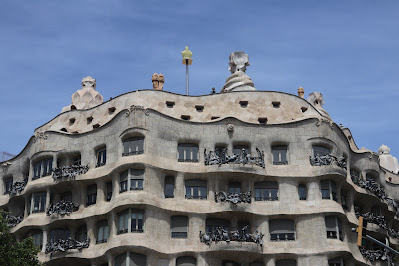 |
| View from Montjuic Park |
We’re docked in the small ship port near the Columbus
Statue in Barcelona’s
harbor. The city was founded by the Romans in the first century BC and now has
1.7 million people. We started with a bus tour of Montjuic Park, home of
the 1992 Olympics and now the site of many sports complexes and eleven museums,
originally built as pavilions for the 1929 exhibition. We stopped for a
panoramic view of the city with Sacred
Heart Church on the opposite hill side. Then we toured the center of the
city until we reached the beaches with Gold Fish designed by Frank Gehry nearby
and the W hotel looking like a wave in the distance.
We had time to the exterior of Sagrada Familia,
Antoni Gaudi’s life work after 1914. The church cornerstone was laid in 1882. He
was hired as the second architect in 1883. Over the years, he changed the design from a
simple church to the unique design we see today with 18 towers: 12 for the
apostles, 4 for the evangelists, Christ and Mary. There will be three facades: the
Nativity, the Passion, and the Glory. We spent our time studying the earliest
façade, the Nativity. Only one tower was completed by the time of Gaudi’s death
in 1926. The tower of the Virgin Mary
was completed in 2021. The glory façade is still not started.
 |
| La Pedrera |
After lunch, we had a tour of Gaudi’s La Pedrera, a 20 story apartment building like no other. The exterior is all curves. In front is a Statue by Jaume Plensa. With its central courtyard all the rooms have natural light including what were servant quarters. The top floor has a vaulted ceiling. Once the laundry, now it is a Gaudi museum. The roof is unique with its art works.
 |
| Sagrada Familia - the Passion |
I had the opportunity to visit the interior of Sagrada Familia
in the afternoon. When we were here in 2004, the church had no ceiling. The
Basilica was dedicated by the Pope in 2010. The colors coming from the stained-glass
windows created a colorful environment hard to capture in photos.
 |
| Interior of Sagrada Familia |
We headed home the next day, despite a cancelled flight and a 3 hour delay on another, we did make it home safely, but exhausted.
The summary: We had two great guides with Maria and Victor. The 'yellow' group got along great and everyone stayed healthy. I really appreciated that folks shared their photos with me. The highlights of the trip: The April Festival in Seville was interesting, seeing everyone in their flamenco dresses and suits enjoying themselves till all hours. May Day in Valencia was exciting - all the different folks we saw. The Cathedral - Mosque in Cordoba was unique, such a change from other parts of the world. Finally, it was great to revisit Sagrada Familia - what a gorgeous work of art, especially compared to our visit in 2004.






